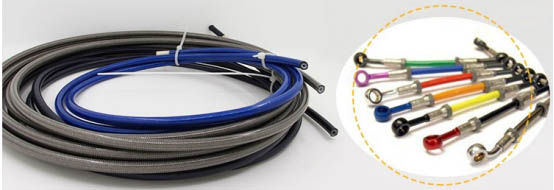You might get your motorcycle serviced regularly, make timely repairs, replace parts, etc. However, situations that are not in your control may arise and there will be times when you would not find a garage or a mechanic nearby. It is during these times that you need to be able to make some basic repairs yourself. Now, if you are not a grease monkey, there are quite a few repairs that you would not be able to make. However, minor repairs like fixing a puncture can be done easily. A puncture, while common, might not be the only thing that may go wrong though. There are other components that might wear out or break due to a variety of reasons. Among such failures, the clutch and brake lines are two of the most common components that are prone to breakage. In this article, we will talk about replacing the PTFE clutch and the brake line if they were to wear out while you were riding. The clutch or brake line snapping will be a rare occurrence if you replace them from time to time. However, like life, most things are uncertain and if you were to find yourself in a situation where you need to replace them, this guide will help you out. If not for yourself, you might be able to help out a stranded fellow rider whose brake or clutch line were broken.
Carry necessary tools and equipment
The scenario where you would be required to replace the PTFE clutch or brake line all by yourself will arise mostly when you are riding long distance. The constant application of brakes and engagement of the clutch might cause them to wear off. That’s when you might find yourself stranded on the highway. Hence, when you set out for a long trip, carry a spare set of PTFE clutch and brake lines. Make sure you buy genuine lines that your motorcycle manufacturer sells or recommends. Using cheap or third-party lines run an increased chance of breakage, and their use might also cause long term damage to other components of the motorcycle. Also, genuine lines will be of the right length and equipped with all the required springs and nuts for a proper fitment. Besides the lines themselves, you might only require a spanner or a plier to loosen the nuts. Some grease might also come in handy but is not absolutely necessary.
Replacing The lines
Replacing both the PTFE clutch and brake lines is fairly easy, however, you need to be careful about some steps to ensure that the lines are installed properly and perform as they should. You would not want them to break again due to improper fitment. If that happens you have already used up your spare, unless of course you have another extra PTFE line. To make things easier, here’s a step by step guide you can refer to.
1. Identify the point of wear/break
2. Loosen the nut which attached the PTFE line to the brakes. The position of this nut will be different on motorcycles with drum brakes and disc brakes. Carefully identify the nut before loosening it.
3. Once the nut is loose, you should be able to pull out the PTFE line from the point of attachment. If there is any resistance, it could be because of the piece of metal that is soldered on the PTFE line. This piece is referred to as a nipple and it works like a hook or an anchor to the braking unit. When the brake is engaged, it works like a finger pulling the trigger and applies the brakes. Carefully navigate the nipple out of the groove that is provided to take it out.
4. Once the brake end of the line is detached, it’s time to detach the lever end. Brake levers have adjusters to adjust the tightness of the PTFE line. Loosen the PTFE line to the point where there is least resistance.
5. Once the PTFE line is loose, align the groove on the nut with the groove on the lever and carefully pull the PTFE line out.
6. Just like the brake end of the PTFE line, the lever end too has a nipple and the lever has a groove below it where the nipple is slotted. Locate the slot and pull the nipple out.
7. Now, your PTFE line is free from both ends. Do not pull it out fully yet.
8. Carefully map the path the PTFE line has been fitted in from the lever to the brakes. The new PTFE line will need to follow the same path so that it does not interfere with other parts of the motorcycle.
9. Once you have charted the path, pull the line out slowly. Do not pull it out in a hurry as it might damage some other components.
10. If your new PTFE line does not have springs, preserve the old ones and use them with the new line.
11. Now, identify the lever and brake ends of the new PTFE line and attach the lever end of the line by pushing the nipple into the groove.
12. Once the lever end is slotted correctly, run the PTFE line through the path all the way to the brake end.
13. Slot the brake end of the nipple into the brake groove and tighten the nut.
14. Adjust the tightness of the line to get the desirable tension for brake application.
15. Test it out by riding at a slow and controllable speed. If everything seems okay, you are good to resume your journey.
The PTFE clutch line too has the same mechanism and the above steps can be applied to change the PTFE clutch line as well. The only difference will be the position of either ends of the line.
Now, replacing the PTFE lines yourself shouldn’t be exclusively for breakdowns or emergencies. If you are a DIY person, you will enjoy the process and the sense of achievement of replacing the lines yourself successfully. Go ahead, try the steps out on your motorcycle, so that you are better prepared to carry out the procedure if any of the PTFE lines break during a ride, or to help a fellow rider who’s stuck in a similar situation.
Buying the right PTFE brake line is not only about choosing different specifications for different applications. More to choose a reliable manufacturer. Besteflon Fluorine plastic Industry Co., Ltd. specializes in the production of high-quality PTFE hoses and tubes for 15 years. If any questions and needs, please feel free to consult us for more professional advice.

Post time: Nov-07-2023
